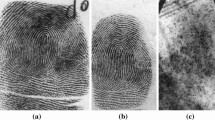Abstract
Overlapped fingerprints are often found in latent fingerprints lifted from crime scenes and in live-scan fingerprint images when the surface of fingerprint sensors contains residues of fingerprints of previous users. Such overlapped fingerprints usually cannot be processed accurately by contemporary commercial fingerprint matchers, which has led many researchers to propose methods designed to separate the overlapped fingerprints. In this paper, we propose a novel latent overlapped fingerprints separation algorithm based on neural networks. Our algorithm works in a block-based fashion. After producing an initial estimation of the orientation fields present in the overlapped fingerprint image, it uses a neural network to separate the mixed orientation fields, which are then post-processed to correct remaining errors and enhanced using the global orientation field enhancement model. Experimental results show that the proposed algorithm outperforms the state-of-the-art algorithm in terms of accuracy on the Tsinghua Overlapped Latent Fingerprint Database (containing real-world overlapped fingerprints obtained by forensic methods), while also showing encouraging results (second only to state-of-the-art) on the Tsinghua Simulated Overlapped Fingerprint Database (containing artificially overlapped fingerprints of a good quality).


















Similar content being viewed by others
References
Chen F, Feng J, Jain A, Zhou J, Zhang J (2011) Separating overlapped fingerprints. IEEE Trans Inf Forensics Secur 6(2):346–359. ISSN 1556-6013.doi:10.1109/TIFS.2011.2114345
Chetty G, Wagner M (2006) Multi-level liveness verification for face-voice biometric authentication. In: Biometrics symposium: special session on research at the biometric consortium conference, 2006. IEEE, pp 1–6
DeCann B, Ross A (2013) Relating ROC and CMC curves via the biometric menagerie. In: IEEE sixth international conference on biometrics: theory, applications and systems (BTAS), 2013.doi:10.1109/BTAS.2013.6712705, pp 1–8
Feng J, Shi Y, Zhou J (2012) Robust and efficient algorithms for separating latent overlapped fingerprints. IEEE Trans Inf Forensics Secur 7(5):1498–1510. ISSN 1556-6013. doi:doi:10.1109/TIFS.2012.2204254doi:10.1109/TIFS.2012.2204254
Feng J, Zhou J, Jain A (2013) Orientation field estimation for latent fingerprint enhancement. IEEE Trans Pattern Anal Mach Intell 35(4):925–940. ISSN 0162-8828.doi:10.1109/TPAMI.2012.155
Gorodnichy D (2011) Multi-order biometric score analysis framework and its application to designing and evaluating biometric systems for access and border control. In: IEEE Workshop on computational intelligence in biometrics and identity management (CIBIM), 2011.doi:10.1109/CIBIM.2011.5949204, pp 44–53
Gorodnichy DO (2010) Multi-order analysis framework for comprehensive biometric performance evaluation. In: SPIE defense, security, and sensing. International Society for Optics and Photonics, pp 76670G–76670G
Hassoun MH (1995) Fundamentals of artificial neural networks. MIT Press
Jain A, Feng J (2009) Latent palmprint matching. IEEE Trans Pattern Anal Mach Intell 31(6):1032–1047. ISSN 0162-8828.doi:10.1109/TPAMI.2008.242
Jain A, Flynn P, Ross AA (2007) Handbook of biometrics. Springer Science & Business Media
Maio D, Maltoni D, Cappelli R, Wayman JL, Jain AK (2002a) FVC2002: second fingerprint verification competition. In: 16Th international conference on pattern recognition, 2002. Proceedings, vol 3. IEEE, pp 811–814
Maio D, Maltoni D, Cappelli R, Wayman JL, Jain AK (2002b) FVC2002: the second international fingerprint verification competition. http://bias.csr.unibo.it/fvc2002/
Maltoni D, Maio D, Jain A, Prabhakar S (2009) Handbook of fingerprint recognition. Springer Science & Business Media
Msiza IS, Mathekga ME, Nelwamondo FV, Marwala T (2011) Fingerprint segmentation: an investigation of various techniques and a parameter study of a variance-based method. International Journal of Innovative Computing, Information, and Control (IJICIC) 7:5313–5326
Orczyk T, Wieclaw L (2011) Fingerprint ridges frequency. In: Third world congress on nature and biologically inspired computing (naBIC), 2011. IEEE, pp 558–561
Rosenfeld A, Hummel RA, Zucker SW (1976) Scene labeling by relaxation operations. IEEE Trans Syst Man Cybern 6:420–433
Shi Y, Feng J, Zhou J (2011) Separating overlapped fingerprints using constrained relaxation labeling. In: Proceedings of the international joint conference on biometrics
Tamura S, Tateishi M (1997) Capabilities of a four-layered feedforward neural network: four layers versus three. IEEE Trans Neural Netw 8(2):251–255. ISSN 1045-9227.doi:10.1109/72.557662
Zhang N, Yang X, Zang Y, Jia X, Tian J (2014a) Overlapped fingerprints separation based on adaptive orientation model fitting. In: 22nd international conference on pattern recognition (ICPR), 2014, pp 678–683, DOIdoi:10.1109/ICPR.2014.127, (to appear in print)
Zhang N, Zang Y, Yang X, Jia X, Tian J (2014b) Adaptive orientation model fitting for latent overlapped fingerprints separation. IEEE Trans Inf Forensics Secur 9(10):1547–1556. ISSN 1556-6013.doi:10.1109/TIFS.2014.2340573
Zhao Q, Jain A (2012) Model based separation of overlapping latent fingerprints. IEEE Trans Inf Forensics Secur 7 (3):904–918. ISSN 1556-6013.doi:10.1109/TIFS.2012.2187281
Author information
Authors and Affiliations
Corresponding author
Rights and permissions
About this article
Cite this article
Stojanović, B., Nešković, A. & Marques, O. A novel neural network based approach to latent overlapped fingerprints separation. Multimed Tools Appl 76, 12775–12799 (2017). https://doi.org/10.1007/s11042-016-3696-4
Received:
Revised:
Accepted:
Published:
Issue Date:
DOI: https://doi.org/10.1007/s11042-016-3696-4




